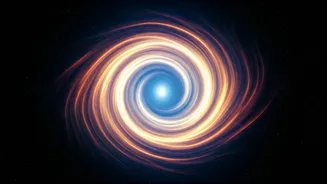Unveiling Dark Matter
Dark matter, an invisible substance, constitutes the majority of the universe's mass. Scientists are aware of it due to its gravitational effects, even
though it doesn't interact with light, making it undetectable by conventional means. Previous models often portrayed dark matter as evenly distributed in a spherical halo surrounding galaxies like our Milky Way. However, recent observations have presented a challenge to this long-held perspective. A new theory proposes that dark matter might be flattened rather than spherical, with its structure possibly resembling a pancake or a disk rather than a sphere. The shift in perspective has major implications for how we comprehend the structure and evolution of the universe.
A Galactic Glow
One of the most intriguing pieces of evidence supporting the flattened dark matter theory comes from the center of the Milky Way. Telescopes have detected a perplexing excess of gamma rays, a type of high-energy radiation, in the galactic core. Scientists have struggled to explain this excess, but it's consistent with dark matter particles annihilating each other. Traditional models assuming a spherical dark matter halo struggle to account for the intensity and distribution of this gamma-ray glow. If dark matter is flattened, the increased concentration of particles in a disk-like structure could naturally explain the intense radiation observed at the galactic center. This suggests a compelling link between the shape of dark matter and the observed gamma-ray emission.
Implications Examined
The shift toward flattened dark matter holds wider implications for cosmology. It suggests that our understanding of galaxy formation, the distribution of matter, and the interactions within galaxies might need adjustments. If dark matter is flattened, it could influence how galaxies merge, how stars are distributed, and even how the supermassive black hole at the center of the Milky Way behaves. Moreover, this new approach could help refine existing dark matter models, potentially paving the way for more precise simulations of the universe's evolution. Scientists are eager to collect more data and refine their models to gain a clearer understanding of dark matter’s shape and its impact on cosmic structures.
Future Research Pathways
To confirm the flattened dark matter hypothesis, scientists need additional data and analysis. They plan to use advanced telescopes, like the James Webb Space Telescope and others, to conduct detailed observations of the galactic center and other regions of the universe. This includes precise measurements of the gamma-ray distribution and further investigations into the gravitational effects of dark matter. Further research will aim to develop more complex simulations to study how a flattened dark matter distribution impacts galaxy formation and evolution. The study of dark matter is ongoing, and it's always evolving with new findings and concepts to get closer to the truth about our cosmos. This could reshape our cosmic understanding.













